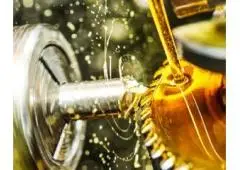Enhancing Cutting Oil Performance with Lubricity Improvers
Description
In the realm of metalworking, cutting oils play a crucial role in lubricating, cooling, and protecting cutting tools and workpieces during machining operations. To optimize the performance of cutting oils and improve the efficiency of metalworking processes, lubricity improvers are often incorporated into these fluids. Let's delve into the significance, functions, and benefits of lubricity improvers in cutting oils:
Understanding Lubricity Improvers:
Lubricity improvers, also known as friction modifiers or lubricating additives, are chemical compounds added to cutting oils to enhance their lubricating properties. These additives form a protective film or boundary layer between the cutting tool and workpiece, reducing friction, heat generation, and wear during machining operations. Lubricity improvers can be organic or inorganic compounds, surfactants, esters, or polar molecules that interact with metal surfaces to minimize friction and improve tool life.
Key Functions and Benefits:
Reduced Friction: Lubricity improvers reduce friction between the cutting tool and workpiece, resulting in smoother cutting action, reduced heat generation, and decreased tool wear. This leads to improved surface finish, dimensional accuracy, and overall machining efficiency.
Extended Tool Life: By minimizing friction and wear, lubricity improvers help extend the lifespan of cutting tools, reducing the frequency of tool changes and associated downtime. This translates to cost savings and improved productivity in metalworking operations.
Enhanced Cooling: Lubricity improvers facilitate better heat dissipation during machining, improving the cooling effect of cutting oils and preventing thermal damage to cutting tools and workpieces. This is particularly crucial in high-speed and high-temperature machining applications.
Improved Surface Quality: The presence of lubricity improvers in cutting oils promotes smoother chip formation and evacuation, reducing the likelihood of built-up edge formation, surface defects, and workpiece distortion. This results in superior surface finish and dimensional accuracy of machined parts.
Optimized Machining Parameters: By enhancing lubrication and reducing friction, lubricity improvers enable the optimization of machining parameters such as cutting speed, feed rate, and depth of cut. This allows for higher machining speeds and feeds without compromising tool life or surface quality.
Compatibility with Various Materials: Lubricity improvers are formulated to be compatible with a wide range of materials commonly encountered in metalworking, including ferrous and non-ferrous metals, alloys, and composites. This versatility makes them suitable for diverse machining applications across different industries.
Considerations and Application:
Dosage and Concentration: The optimal dosage and concentration of lubricity improvers in cutting oils depend on factors such as the type of machining operation, material being machined, cutting conditions, and the specific requirements of the application. It is essential to follow manufacturer recommendations and conduct periodic testing to ensure proper performance.
Compatibility with Other Additives: Lubricity improvers should be compatible with other additives present in cutting oils, such as corrosion inhibitors, anti-wear agents, and extreme pressure additives. Compatibility testing should be conducted when formulating or blending cutting oil formulations to avoid adverse interactions.
Environmental and Health Considerations: When selecting lubricity improvers, it is essential to consider their environmental impact and health hazards. Where possible, environmentally friendly and biodegradable lubricity improvers should be preferred to minimize environmental pollution and health risks associated with exposure.
Conclusion:
In conclusion, lubricity improvers play a vital role in enhancing the performance of cutting oils and optimizing metalworking processes. By reducing friction, heat generation, and tool wear, these additives contribute to improved machining efficiency, extended tool life, and superior surface quality of machined parts. When selecting and using lubricity improvers, it is essential to consider factors such as dosage, compatibility, environmental impact, and health considerations to ensure optimal performance and safety in metalworking operations.
Lubricity additive
Lubricity enhancer
Lubricity improver for metalworking fluids
Cutting oil lubricity improver
Lubricity Improver for coolant
Lubricity Improver
Lubricity Enhancer
Lubricity Additives
Lubricity Agent
Lubricity Improver for cutting oil
Lubricity Improver for metal working fluid
Lubricity Agent for cutting oil
Lubricity Agent for metal working fluid
Lubricity Agent for soluble oil
Lubricity agent for water based cutting oil






Useful information
- Avoid scams by acting locally or paying with PayPal
- Never pay with Western Union, Moneygram or other anonymous payment services
- Don't buy or sell outside of your country. Don't accept cashier cheques from outside your country
- This site is never involved in any transaction, and does not handle payments, shipping, guarantee transactions, provide escrow services, or offer "buyer protection" or "seller certification"





